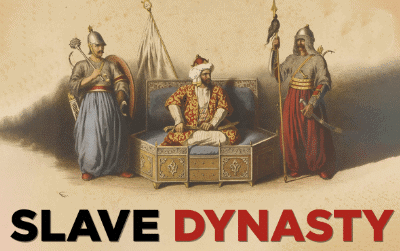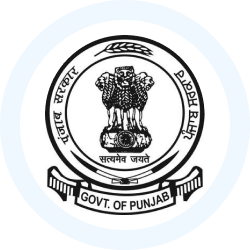Delhi Sultanate of Punjab | Punjab State (PPSC) PSC: Preparation - PPSC PCS (Punjab) PDF Download
The Slave Dynasty (1206-90 CE)

The Delhi Sultanate, also known as the Slave dynasty, was established by the successors of Muhammad Ghori. The main rulers of the Slave dynasty included:
Qutb-ud-din Aibak
- Qutb-ud-din Aibak, a former slave of Muhammad Ghori, founded the Slave dynasty, which ruled from 1206 to 1290 CE.
- Aibak was the first Sultan of this dynasty, ruling from 1206 to 1210 CE. Under his rule, Sirhind, including present-day Rupnagar district, became an important administrative unit.
Iltutmish
- Iltutmish succeeded Aibak and ruled from 1211 to 1236 CE. He is considered the real founder of the Delhi Sultanate and played a crucial role in establishing its authority.
- During his reign, in 1221 CE, the Mongols, led by Genghis Khan, appeared on the banks of the Indus River for the first time, but India managed to escape Mongol invasions during Iltutmish's rule.
- Iltutmish made significant reforms, including organizing the Iqta system and improving civil administration and the army in Punjab. He also moved the capital from Lahore to Delhi.
Razia
- In 1236, Iltutmish appointed his daughter, Razia, as his successor. Razia was the first woman ruler of India, but she faced opposition from the nobles who preferred a male ruler.
- Her assertiveness led to conflicts with the nobles, and she was eventually overthrown and killed by her brother, Muiz-ud-din Bahram, in 1240 CE.
Balban
- Balban ruled from 1246 to 1287 CE and made significant contributions to the dynasty.
- He appointed his cousin, Sher Khan, as the Governor of Sirhind (Punjab) and surrounding areas. Sher Khan was an effective administrator who defended the region against Mongol attacks.
- However, Sher Khan became too powerful, posing a threat to Balban's authority. To eliminate this threat, Balban poisoned Sher Khan and replaced him with his son, Prince Sultan, as the Governor of Sirhind.
- Prince Sultan continued to govern effectively but died in 1285 while fighting against the Mongols.
The Khilji Dynasty (1290-1320 CE)
Jalal-ud-din Khilji was the first ruler of the Khilji dynasty. He was killed by his nephew, Ala-ud-din Khilji, on July 19, 1295. Ala-ud-din Khilji became the most powerful ruler of the dynasty.
- In 1298, the Mongols, led by Kutlugh Khan, invaded Punjab. In 1304, they invaded again, and Ghazi Malik (later known as Ghiyasuddin Tughlaq), the Governor of Punjab, was sent to oppose them with a large force.
- Ala-ud-din Khilji introduced significant fiscal, land, and agrarian reforms in Northern India and established an irrigation system in Punjab. He ruled for over 20 years and died on December 19, 1316.
The Tughlaq Dynasty (1320-1414 CE)
- Ghiyasuddin Tughlaq, originally named Ghazi Malik, established the Tughlaq dynasty. The most notable rulers of this dynasty were Muhammad-bin-Tughlaq and Firoz Shah Tughlaq.
- Muhammad-bin-Tughlaq, in 1327, faced an invasion from Tarmashirin Khan, a Mongolian General, who attacked the Punjab region. However, the emperor managed to persuade the General to withdraw by offering a substantial sum of money.
- In 1341, the Punjab was again invaded, this time by the Ghakkars, but they were defeated and forced to leave the region.
- During the reign of Firoz Shah Tughlaq, Punjab thrived and became prosperous, with a particular focus on agriculture.
- Firoz Shah Tughlaq is credited with being the true pioneer of the canal irrigation system in Punjab.
- He also constructed an impressive palace along the banks of the Saraswati River and established a new city near Delhi, named Firozabad.
Invasion of Timur
In 1398, Timur invaded northern India, crossing the Indus River and advancing towards Lahore. The Delhi Sultanate was unable to mount a strong resistance against him. After amassing a substantial amount of wealth, Timur began his journey back to his homeland, passing through Punjab and parts of present-day Ambala, Rupnagar, Hoshiarpur, and Kangra. He spent 15 days in Delhi before returning to his country.
The Sayyid Dynasty (1414-1451 CE)
- The Sayyid dynasty ruled the Delhi Sultanate from 1414 to 1451 CE.
- Khizr Khan, the founder of the dynasty and a former Governor of Punjab under Timur, took the throne in 1414 CE.
- He was succeeded by Mubarak Shah in 1421 CE.
- Mubarak Shah was followed by Muhammad Shah and Ala-ud-din Alam Shah.
- During Alam Shah's reign, he appointed a governor to oversee the administration in Delhi.
- This led to Bahlol Lodhi seizing control of Delhi in 1451.
The Lodhi Dynasty (1451-1526 CE)
The Lodhi dynasty was established by Bahlol Lodhi, who, along with his successor Sikandar Lodhi, managed to control Punjab with relative ease. However, during the reign of Ibrahim Lodhi, Daulat Khan Lodhi, the Viceroy of Punjab, provoked Babur to invade the region. This led to Babur defeating Ibrahim Lodhi at the Battle of Panipat in 1526, effectively ending the Lodhi dynasty.
|
23 videos|50 docs|47 tests
|
















